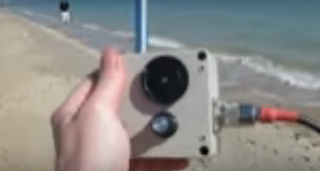As a rough rule the smaller the antenna the less efficient it is. That can be somewhat mitigated by making its bandwidth narrow by making it high Q like a magnetic loop. But even there losses become overwhelming when the antenna gets tiny. And a high Q antenna requires extraordinary quality of construction (eg thick low resistance elements and excellent connections) to deliver anywhere near its estimated performance. And short verticals require extreme attention to ground systems that are longer, bigger or heavier than the antenna itself.
There are however cases when people are willing to compromise antenna performance for the smallest possible size. They might be satisfied to be receiving 90% of the time. Or confine themselves to highly efficient non-QSO digital modes like WSPR. Or mainly transmit on bands like 10m where a short vertical will be more efficient there than on 20 or 40 metres.
Small whips, such as usable for the above purposes, were really popular around 2001. The timing was perfect. The revolutionary Yaesu FT817 had just come out. Although of mediocre capacity, its internal batteries had made it a truly portable transceiver. The only thing missing was an equally portable antenna, preferably self-supporting without a need for a tree or pole. Although efficient digital modes hadn't reached their current development, the strong sunspot peak of the time made long distance contacts on 28 MHz possible. Even on SSB. Even with tiny antennas.
To meet this demand there were commercial products like the Miracle Whip. This was a small telescopic whip that allowed operation on numerous bands. You'd adjust for maximum noise on receive and VSWR would be passably low for transmit (although note that low VSWR does not imply low loss!). It could be plugged straight in to the FT817 to form a small portable transceiving package. Receiving performance was acceptable, but due to its size the transmitting performance put it in the 'novelty antenna' class.
More recently, although sunspots are down, modes like WSPR have made ultra-small antennas useful for transmitting as well as receiving again. Here's some ideas if you wish to build your own or use those that are commercially available.
* Short pedestrian mobile whip for 7 to 28 MHz - basically my version of the Miracle Whip
* Some experiences with a Diamond whip antenna VK3YY VK1NAM
* AA3SJ short whip tuner
* SM0VPO short antenna
* G3YCC portable HF whip
* G4FON musings on the Miracle Whip design
* G7DIE portable 20m whip (video)
* PA1CA's look at the Miracle Whip
As long as your expectations for transmit performance aren't too high, projects like these are a lot of fun. And when signals are strong, don't dismiss the chance of transmitting success, even on SSB. Please let us know your experiences of these antennas, or if you have a favourite design, in the comments below.
PS: Wish to explore other facets of amateur radio? These favourably reviewed books might help.
There are however cases when people are willing to compromise antenna performance for the smallest possible size. They might be satisfied to be receiving 90% of the time. Or confine themselves to highly efficient non-QSO digital modes like WSPR. Or mainly transmit on bands like 10m where a short vertical will be more efficient there than on 20 or 40 metres.
To meet this demand there were commercial products like the Miracle Whip. This was a small telescopic whip that allowed operation on numerous bands. You'd adjust for maximum noise on receive and VSWR would be passably low for transmit (although note that low VSWR does not imply low loss!). It could be plugged straight in to the FT817 to form a small portable transceiving package. Receiving performance was acceptable, but due to its size the transmitting performance put it in the 'novelty antenna' class.
More recently, although sunspots are down, modes like WSPR have made ultra-small antennas useful for transmitting as well as receiving again. Here's some ideas if you wish to build your own or use those that are commercially available.
* Short pedestrian mobile whip for 7 to 28 MHz - basically my version of the Miracle Whip
* Some experiences with a Diamond whip antenna VK3YY VK1NAM
* AA3SJ short whip tuner
* SM0VPO short antenna
* G3YCC portable HF whip
* G4FON musings on the Miracle Whip design
* G7DIE portable 20m whip (video)
* PA1CA's look at the Miracle Whip
As long as your expectations for transmit performance aren't too high, projects like these are a lot of fun. And when signals are strong, don't dismiss the chance of transmitting success, even on SSB. Please let us know your experiences of these antennas, or if you have a favourite design, in the comments below.
PS: Wish to explore other facets of amateur radio? These favourably reviewed books might help.





No comments:
Post a Comment